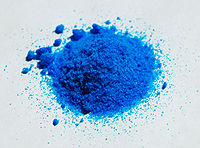This is an old revision of this page, as edited by Beetstra (talk | contribs) at 12:48, 15 February 2012 (Saving copy of the {{chembox}} taken from revid 476729821 of page Copper(II)_nitrate for the Chem/Drugbox validation project (updated: '').). The present address (URL) is a permanent link to this revision, which may differ significantly from the current revision.
Revision as of 12:48, 15 February 2012 by Beetstra (talk | contribs) (Saving copy of the {{chembox}} taken from revid 476729821 of page Copper(II)_nitrate for the Chem/Drugbox validation project (updated: '').)(diff) ← Previous revision | Latest revision (diff) | Newer revision → (diff)| This page contains a copy of the infobox ({{chembox}}) taken from revid 476729821 of page Copper(II)_nitrate with values updated to verified values. |
 | |
 | |
| Names | |
|---|---|
| IUPAC name Copper(II) nitrate | |
| Other names Cupric nitrate | |
| Identifiers | |
| CAS Number | |
| 3D model (JSmol) | |
| ChemSpider | |
| PubChem CID | |
| RTECS number |
|
| UNII | |
InChI
| |
SMILES
| |
| Properties | |
| Chemical formula | Cu(NO3)2 |
| Molar mass | 187.5558 g/mol (anhydrous) 241.60 g/mol (trihydrate) |
| Appearance | blue crystals hygroscopic |
| Density | 3.05 g/cm (anhydrous) 2.32 g/cm (trihydrate) 2.07 g/cm (hexahydrate) |
| Melting point | 256 °C (anhydrous, decomp) 114.5 °C (trihydrate) 26.4 °C (hexahydrate, decomposes) |
| Boiling point | 170 °C (trihydrate, decomposes) |
| Solubility in water | trihydrate: 137.8 g/100 mL (0 °C) 1270 g/100 mL (100 °C) |
| Solubility | hydrates very soluble in ethanol, amomonia, water; insoluble in ethyl acetate |
| Structure | |
| Crystal structure | orthorhombic (anhydrous) rhombohedral (hydrates) |
| Hazards | |
| Occupational safety and health (OHS/OSH): | |
| Main hazards | Irritant, Oxidizer |
| NFPA 704 (fire diamond) |
 |
| Related compounds | |
| Other anions | Copper(II) sulfate Copper(II) chloride |
| Other cations | Nickel(II) nitrate Zinc nitrate |
| Except where otherwise noted, data are given for materials in their standard state (at 25 °C , 100 kPa).
| |
Chemical compound